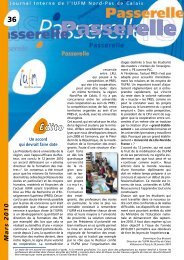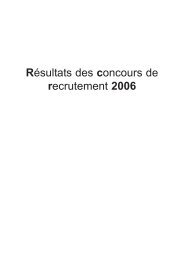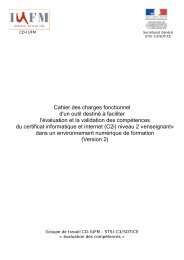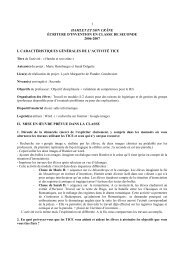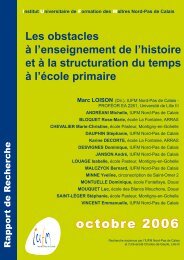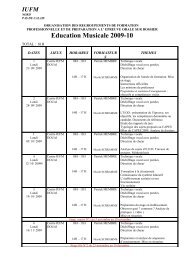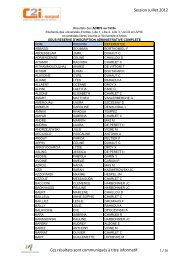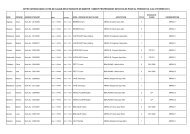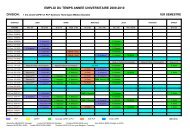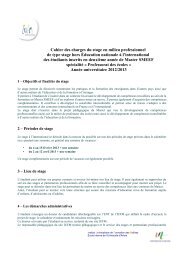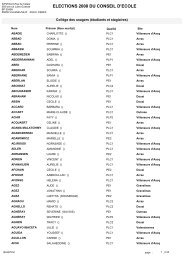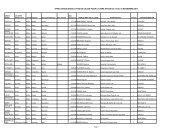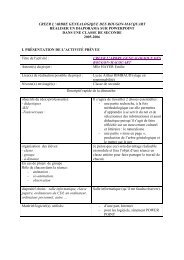You also want an ePaper? Increase the reach of your titles
YUMPU automatically turns print PDFs into web optimized ePapers that Google loves.
Another case can be envisaged, that in which the established ru<strong>le</strong>s are from data corresponding<br />
to observab<strong>le</strong>s on site but also from data perpetuated from these observab<strong>le</strong>s. The stability<br />
of the latter therefore makes c<strong>le</strong>ar groups of “fixed” subjects (the students of a same sociocultural<br />
milieu, “novice” vs. “experienced” teachers etc.) S.I.A. can then provide, either ru<strong>le</strong>s<br />
linking actions, statements, the effects of these actions, of these words and these constituted<br />
groups, or by the study of the contributions of subjects to ru<strong>le</strong>s, establish tendencies shared<br />
by subjects from the same group, or on the contrary, of equally characteristic avoidances.<br />
We will present several cases of studies in mathematical didactics exemplifying these<br />
different usages.<br />
2. Regulations of situated actions, ru<strong>le</strong>s established from observab<strong>le</strong><br />
modalities.<br />
2.1. Asymmetries of ru<strong>le</strong>s established and chronology of tasks<br />
The examp<strong>le</strong> that we develop first is that of the study of responses of students of CM1-<br />
CM2 (9 to 10 years) to an exercise that is composed of two successive tasks. Firstly they<br />
are asked to put into order written decimals and fractions ½ ; 1,5 ; 2 ; 3,5 ; 4 ; 5,15 ; 5,6 ;<br />
6,2 ; 9,5 ; 12 secondly to place them on a graduated line. In French the word numbers<br />
associated with 5.15 and 5.6 are pronounced ‘five comma fifteen” and “five, comma six”.<br />
This way of saying the numbers explains a frequent error at this school <strong>le</strong>vel, which consists<br />
of placing 5.6 before 5.15, by only comparing the decimal parts of these numbers. However<br />
the numbers have been chosen so that the reproduction of this classification error in the<br />
second part of the task <strong>le</strong>ads to a contradiction that the students – still of the school <strong>le</strong>vel<br />
considered – can comprehend. In fact, to put a point corresponding to 5.6 on the graduated<br />
line, then to put one that corresponds to 5.15, in moving back the first one by a space of “9”<br />
( the space between 15 and 6) <strong>le</strong>ads the student to place 5.15 erroneously on the point that<br />
should correspond to 6.5 (5.6+0.9). This placement can seem contradictory with that which<br />
corresponds to 6.2 and other points. We will say in this case that the information given to<br />
the student by the erroneous placing of 5.15 is an e<strong>le</strong>ment of the environment with which<br />
the student interacts.<br />
If consequently we expect certain students to commit errors in the classing of written numbers,<br />
on the other hand, we wonder about the effects of the consequences of these errors during<br />
the execution of the second task. Two types of common considerations in mathematical<br />
didactics allow us to anticipate them. Firstly, the information that the erroneous placement<br />
of the points on the line gives is not “naturally” interpreted in terms of a contradiction. In fact<br />
the reading and the comprehension of this information necessitates the working of certain<br />
know<strong>le</strong>dge : in fact it concerns considering the placement of 5.15 and 6.2 as “strange” and to<br />
consider them as a consequence of the classification error of 5.6 and 5.15. Then the different<br />
works done on the error or the prob<strong>le</strong>m in a scholarly situation <strong>le</strong>ad us to differentiate the<br />
recognition of a student of an error and the realization of that error. Or to put it simply<br />
the perception of a contradiction in his results is often insufficient to <strong>le</strong>ad a student in a<br />
class to invalidate the latter because he still does not feel invested with the responsibility to<br />
resolve the prob<strong>le</strong>m raised (Brousseau, Margolinas). The question of the study of students’<br />
behaviour is therefore a <strong>le</strong>gitimate question.<br />
<strong>IUFM</strong> Nord-Pas de Calais<br />
107




